Building Smarter Robotic Arms in 2025
Discover how Tau Robotics is revolutionizing the robotics industry in 2025 with cutting-edge AI-powered robotic arms. From healthcare to manufacturing, explore their innovative solutions driving smarter automation and shaping the future of robotics.
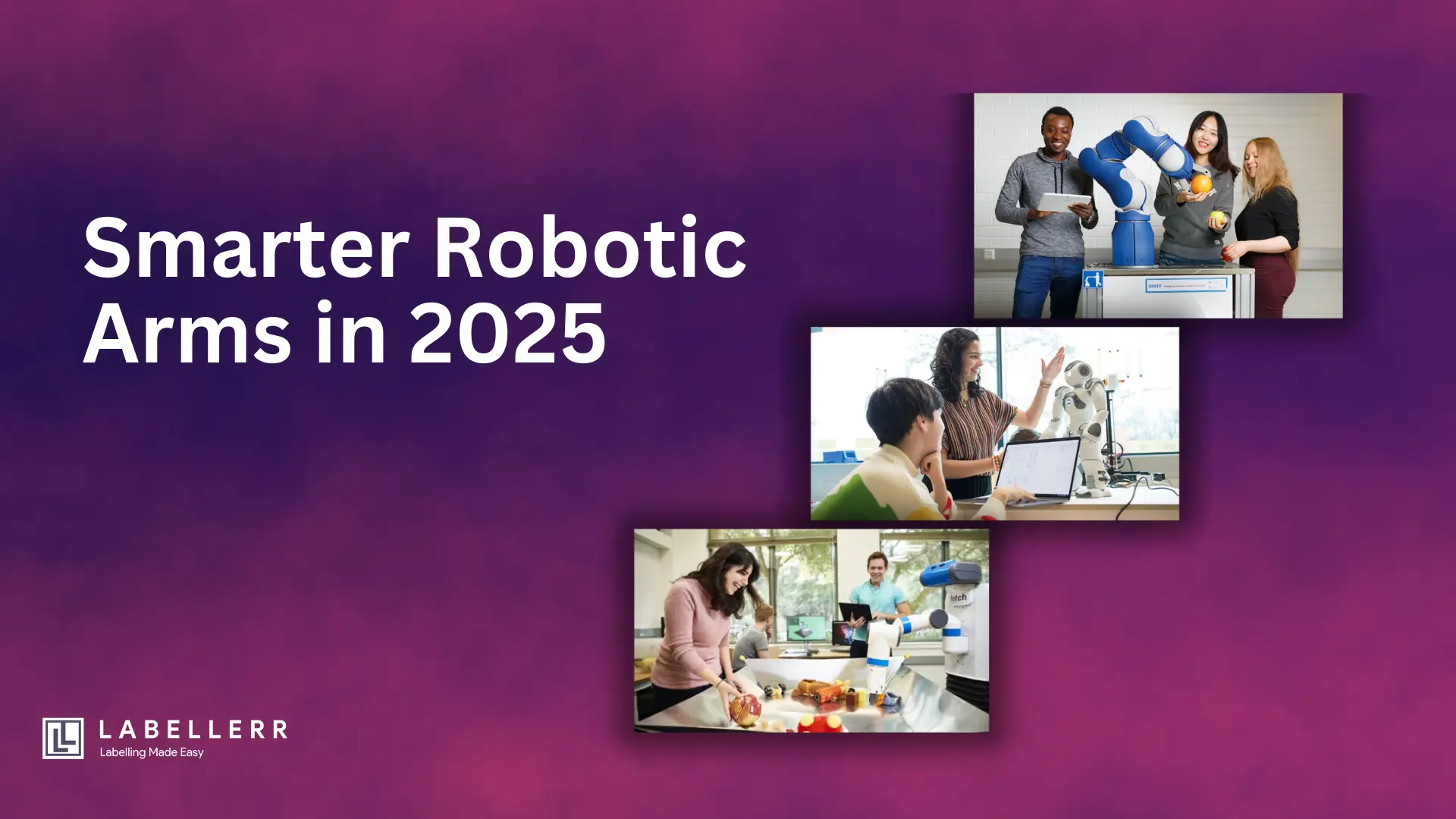
The robotics market is growing fast, with its value expected to reach $192 billion by 2033. This growth is fueled by advancements in artificial intelligence (AI), automation, and the increasing demand for efficiency across industries.
Unlike humanoid robots, which often capture public attention with their ability to mimic human movements, robotic arms remain the preferred choice for industrial applications. They offer greater efficiency, cost-effectiveness, and reliability.
While humanoid robots require advanced sensors and complex AI systems to navigate unpredictable environments, robotic arms are built for specific tasks such as assembly, welding, material handling, and precision surgery.
Their high level of accuracy and force control makes them indispensable in industries where precision is crucial.
Additionally, robotic arms are easier to integrate into existing workflows compared to humanoid robots, which demand extensive programming and infrastructure changes.
Companies can seamlessly adopt robotic arms into factories, warehouses, and hospitals, where they consistently outperform humanoid robots in terms of stability, adaptability, and operational costs.
Humanoid robots, while promising, still struggle with agility, task flexibility, and large-scale deployment, making robotic arms the more practical and scalable option.
As AI continues to evolve, robotic arms are becoming smarter and more autonomous.
With advancements in machine learning and real-time decision-making, they are now capable of learning from data, adapting to new tasks, and working collaboratively with humans.
These innovations will drive the next phase of automation, ensuring that industries can enhance productivity, reduce costs, and address labor shortages without compromising on quality and efficiency.
This article explores the latest innovations, challenges, and future trends shaping robotic arms in 2025 and beyond.
Table of Contents
- Current State of Robotics
- Key Technologies Driving Robotics in 2025
- Industry-Specific Case Studies
- Challenges and Opportunities in Robotics
- Some Examples
- Future Outlook for Robotics Beyond 2025
- Conclusion
- FAQs
Current State of Robotics
Market Overview
The robotics industry in 2025 is experiencing rapid growth, driven by advancements in AI, automation, and IoT. Businesses are increasingly adopting robotics to improve efficiency, reduce costs, and enhance operational performance.
.webp)
AI-powered robots are becoming more adaptable, capable of handling complex tasks with minimal human intervention.
The integration of IoT allows robots to communicate with smart systems, gather real-time data, and make faster decisions.
Companies across industries from manufacturing and healthcare to logistics and agriculture are investing in robotics to optimize workflows and improve productivity.
Market Trends in Robotics for 2025
Growing Demand for Automation
Automation is becoming essential across industries, driving rapid growth in the robotics sector. Businesses in manufacturing, logistics, and e-commerce are deploying robots to streamline repetitive tasks, improve efficiency, and reduce human errors.
For example, automated warehouse robots are managing inventory, picking items, and packing orders faster than human workers.
These robots not only increase speed but also allow businesses to scale operations efficiently while maintaining consistent quality and reducing labor costs.
Expansion of Collaborative Robots
Collaborative robots, or cobots, are playing a bigger role in workplaces. Unlike traditional industrial robots, cobots work alongside humans safely, enhancing productivity without replacing jobs.
Cobots are widely used in industries like healthcare, where they assist in surgeries, and manufacturing, where they handle repetitive tasks while humans focus on problem-solving and innovation.
Equipped with AI-powered sensors, these robots can detect human presence, adjust movements, and ensure a safe working environment.
Focus on Sustainability
Sustainability is now a major factor in robotics development. Companies are designing robots to reduce waste, conserve energy, and optimize resource use.
- In agriculture, robotic arms powered by AI are helping farmers optimize water usage and minimize pesticide application by targeting only affected areas.
- In manufacturing, robots are reducing material waste through precise assembly and automation.
These advancements are helping businesses meet sustainability goals while increasing efficiency.
Companies like Tau Robotics are developing AI-powered robotic arms that enhance productivity while supporting sustainable practices across industries.
Regional Growth
The robotics market is expanding rapidly in different regions, with the U.S., Europe, and Asia leading the way.
- In the U.S., industries such as healthcare, logistics, and advanced manufacturing are adopting robotics in their workflows.
- Europe is focusing on sustainability and automation, particularly in automotive production and agriculture.
- Asia, led by China, Japan, and South Korea, is a global leader in robotics due to heavy investments in manufacturing and AI research.
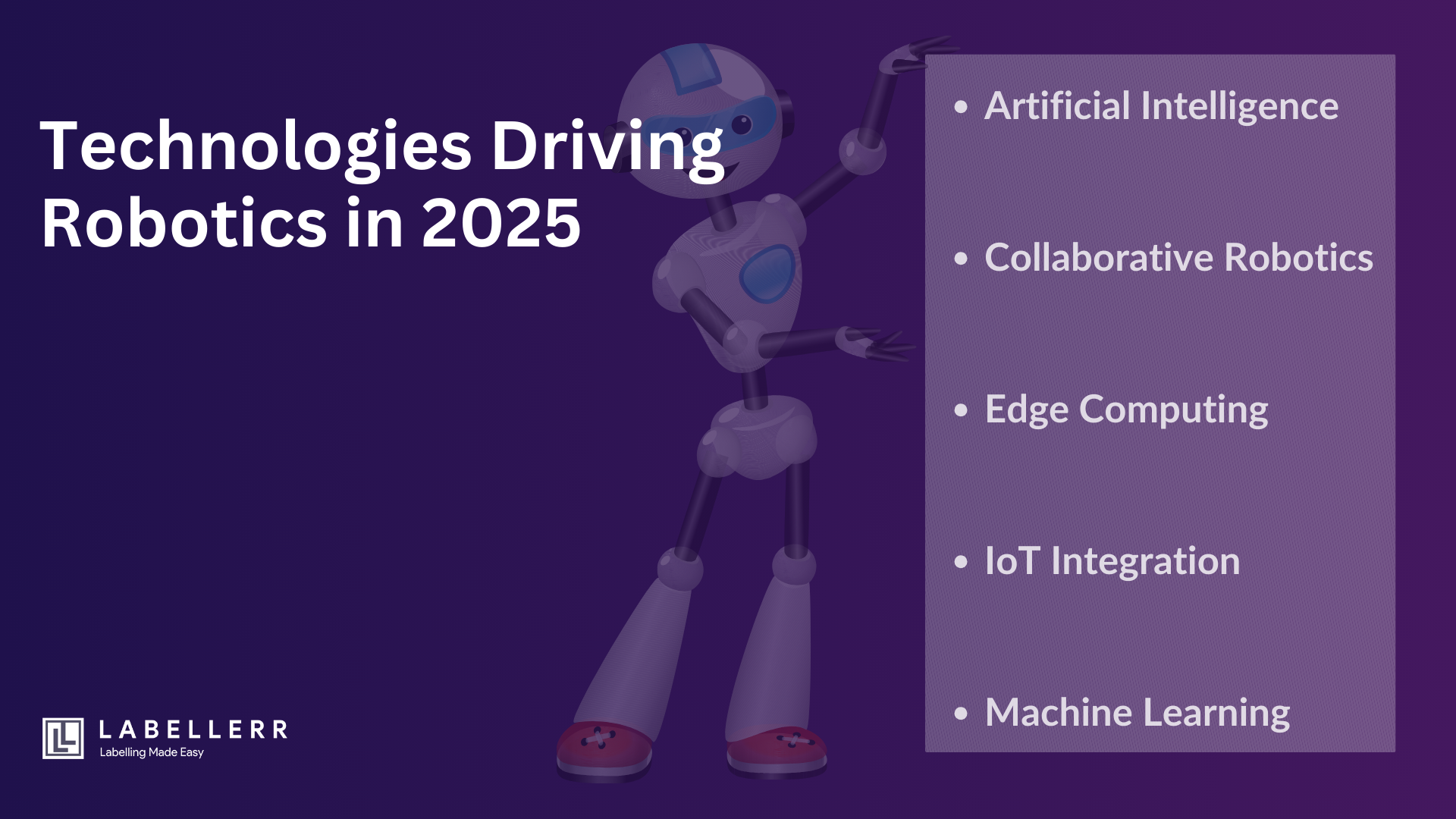
Key Technologies Driving Robotics in 2025
Artificial Intelligence (AI)
AI is at the core of modern robotics, allowing machines to process information, make decisions, and execute tasks with high precision.
AI-powered robots can recognize objects, navigate spaces, and perform complex tasks with efficiency. For example, robots in warehouses can identify and pick items accurately, reducing human error and increasing productivity.
AI also plays a vital role in predictive maintenance, where robots analyze their own performance and anticipate failures before they happen.
This capability is essential in industries like manufacturing and logistics, where unplanned downtime can lead to significant losses.
By detecting potential issues early, AI-driven robots ensure continuous operation and minimal disruptions.
Machine Learning
Machine learning allows robots to learn from data and improve their performance over time.
Unlike traditional robots that follow pre-programmed instructions, ML-enabled robots analyze patterns, adapt to new challenges, and optimize their actions based on past experiences.
For example, in manufacturing, ML-powered robots adjust their movements based on data from previous tasks, ensuring greater precision and consistency in assembly processes.
In agriculture, ML helps robots recognize different crops, determine ripeness, and detect pests, making them more efficient with each use.
ML is also essential for robots working in unstructured environments, such as sorting irregularly shaped objects in logistics or handling unpredictable tasks in customer service.
By continuously improving their capabilities, ML-powered robots become more versatile and reliable in real-world applications.
IoT Integration
The Internet of Things (IoT) connects robots to larger smart systems, enabling real-time data exchange and better decision-making.
IoT-powered robots can communicate with sensors, machines, and cloud platforms, allowing them to react dynamically to changing conditions.
For instance, in smart factories, robots adjust their operations based on live sensor data from production lines. In logistics, IoT-enabled robots track inventory in real-time, ensuring efficient storage and retrieval.
In healthcare, robotic systems connected to IoT networks monitor patient vitals and assist in rehabilitation by adjusting movements based on real-time feedback.
By integrating IoT, robots become more autonomous, responsive, and efficient, reducing waste and improving overall performance across industries.
Edge Computing
Edge computing enables robots to process data locally instead of relying on cloud-based servers. This reduces latency, improves response time, and allows robots to function in real-time without delays.
For example, in autonomous vehicles, robots must make split-second decisions when navigating roads.
Edge computing ensures that robots can process sensor data instantly, improving safety and accuracy. In manufacturing, robots use edge computing to detect defects in real-time, preventing faulty products from reaching the market.
Edge computing also enhances data security, as sensitive information is processed locally instead of being transmitted to external servers. This is especially crucial in industries like healthcare and finance, where privacy is a top priority.
Collaborative Robotics (Cobots)
Collaborative robots (cobots) are designed to work alongside humans, enhancing productivity without replacing jobs.
Unlike traditional industrial robots, which operate in isolated environments, cobots can safely interact with human workers using advanced sensors and AI-driven safety mechanisms.
In manufacturing, cobots assist workers by holding parts, assembling components, or applying precise force where needed, reducing physical strain and improving workflow efficiency.
In healthcare, cobots help medical staff by preparing surgical tools, assisting in patient mobility, or handling repetitive tasks like disinfecting surfaces.
The rise of cobots reflects a shift toward human-robot collaboration, where robots handle repetitive, physically demanding tasks while humans focus on higher-level decision-making and problem-solving.
Industry-Specific Case Studies
Healthcare
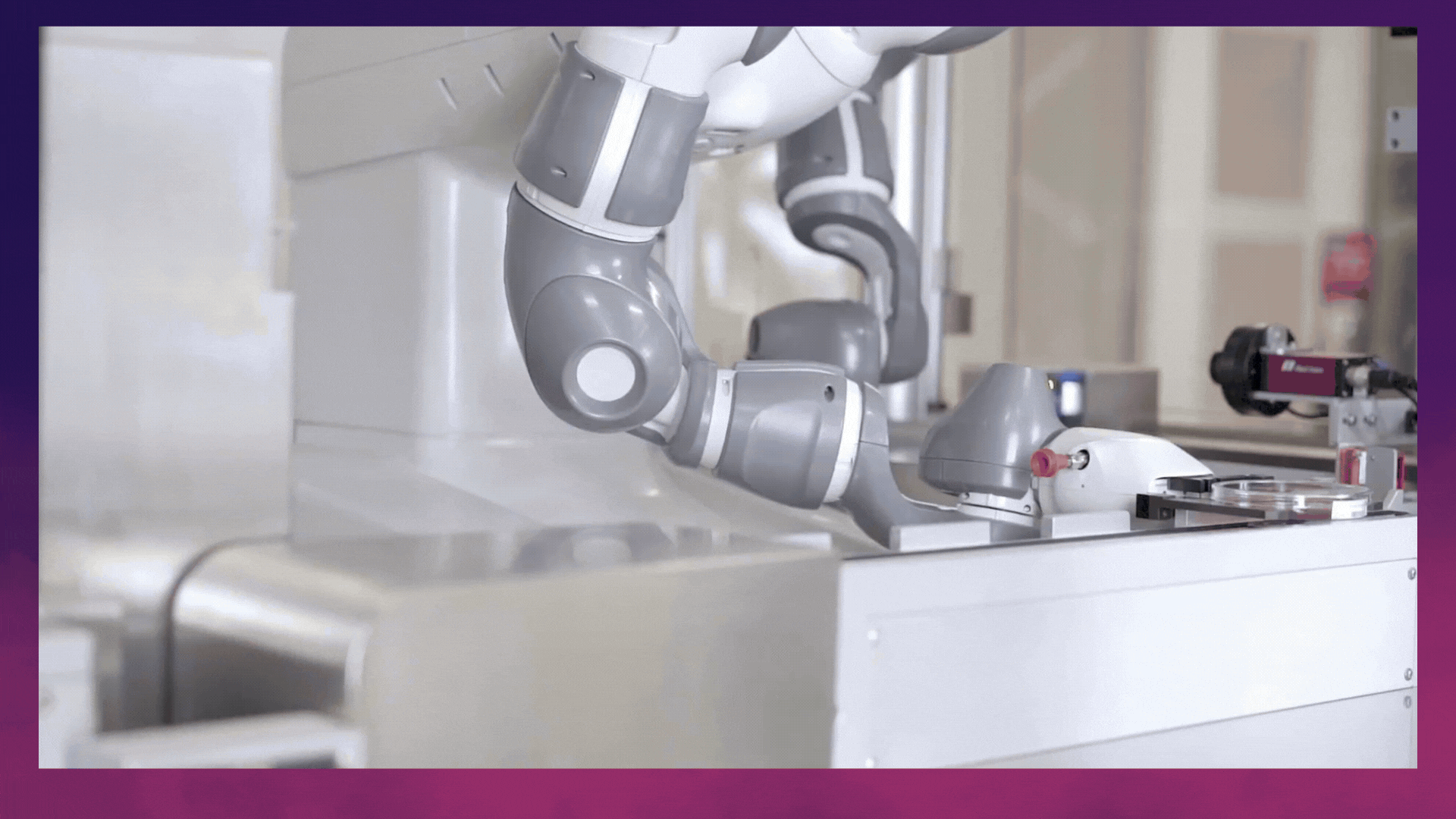
Robotic arms have revolutionized surgical procedures, offering unmatched precision and control.
These robots assist surgeons in performing complex operations with extreme accuracy, minimizing damage to surrounding tissues. This leads to shorter recovery times and fewer complications for patients.
Beyond surgery, robotic arms also support patient care and hospital operations. They help automate tasks like dispensing medication, handling lab samples, and assisting in rehabilitation therapy.
By taking over these repetitive tasks, robotic arms allow healthcare professionals to focus on critical decision-making and patient interaction, improving overall hospital efficiency.
For example, AI-driven robotic arms are used in robotic-assisted laparoscopic surgeries, where they provide stable, precise movements that go beyond human capabilities.
These advancements are making surgeries safer and more effective, improving patient outcomes.
Logistics

The logistics industry is increasingly relying on AI-powered robotic arms to handle the rising demand for e-commerce and supply chain efficiency.
These robots automate sorting, picking, and packaging tasks, significantly speeding up order fulfillment.
For instance, robotic arms equipped with AI and computer vision can recognize different product sizes and shapes, optimizing how items are packed and stored. This automation reduces errors, ensures faster deliveries, and lowers operational costs.
In large fulfillment centers, robotic arms lift heavy packages, arrange inventory, and assist in last-mile sorting.
Their ability to work tirelessly without breaks means warehouses can handle larger volumes of orders with higher accuracy and efficiency.
As demand for faster shipping grows, robotic automation is becoming a necessity in logistics.
Manufacturing

Robotic arms have become essential in modern manufacturing, especially in electronics, automotive, and consumer goods production.
These AI-powered machines improve precision and efficiency in tasks like welding, assembling, and quality inspection.
For example, in electronics manufacturing, robotic arms handle delicate components like circuit boards and microchips, ensuring precise placement without damaging fragile parts.
AI integration allows them to adapt to slight variations in components, improving production consistency and reducing waste.
In automotive factories, robotic arms perform precision welding, painting, and assembling car parts with higher speed and accuracy than human workers.
This automation helps manufacturers maintain quality standards, increase output, and reduce labor costs, making production more scalable and cost-effective.
Agriculture
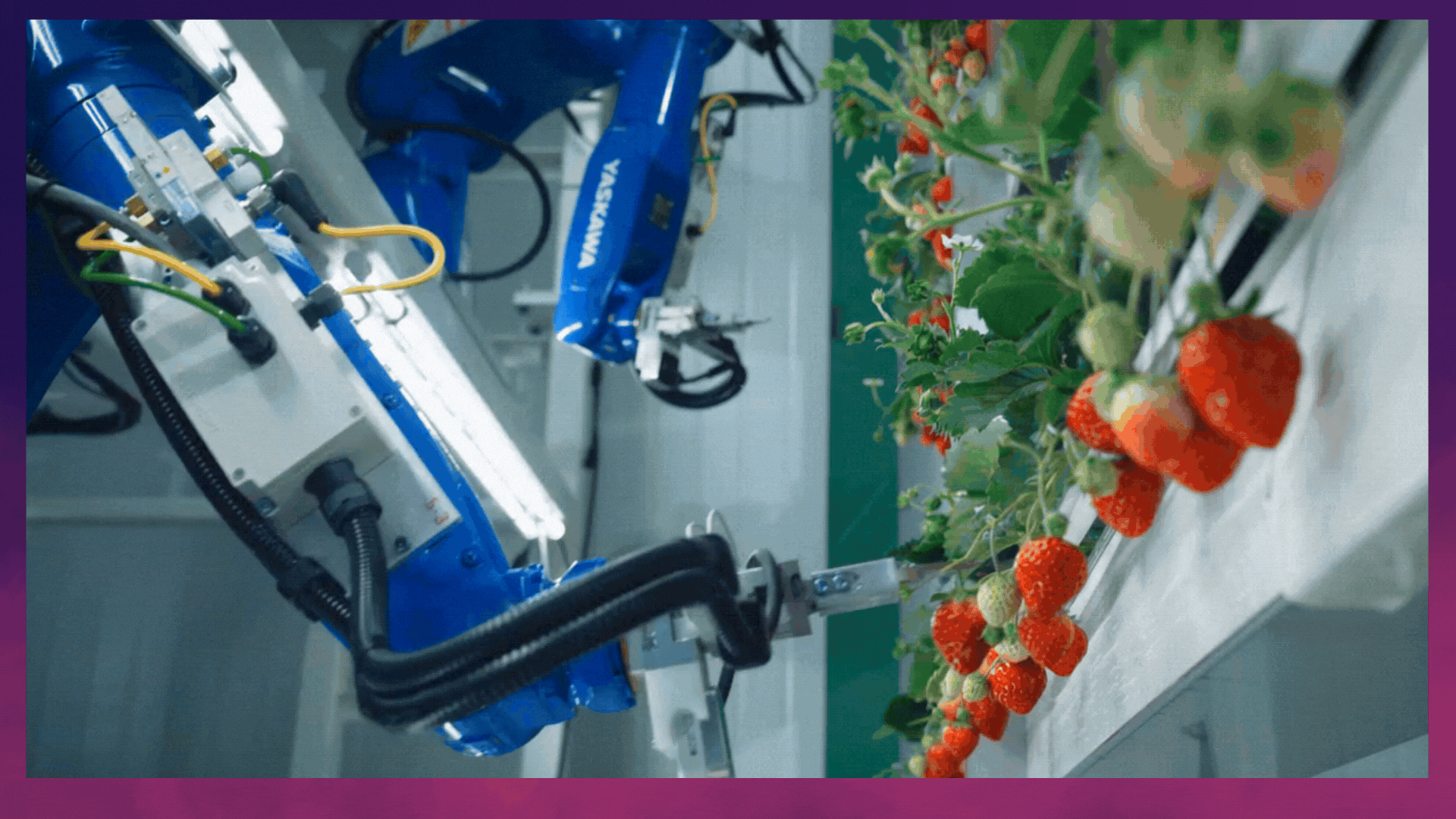
The agriculture industry is using AI-powered robotic arms to improve productivity, reduce labor costs, and minimize food waste.
These robots perform tasks like planting, harvesting, and crop monitoring with precision, helping farmers optimize their operations.
For example, AI-enabled robotic arms are used in precision planting, where they place seeds at optimal depths and spacing for better yield.
In harvesting, robotic arms identify ripe fruits and vegetables using computer vision and pick them without causing damage.
These robots also play a role in pest detection and crop health monitoring, analyzing plants for signs of disease and taking preventive actions before issues spread.
This level of automation helps large farms increase efficiency while using fewer resources, making agriculture more sustainable and profitable.
Challenges and Opportunities in Robotics
Challenges in Robotics
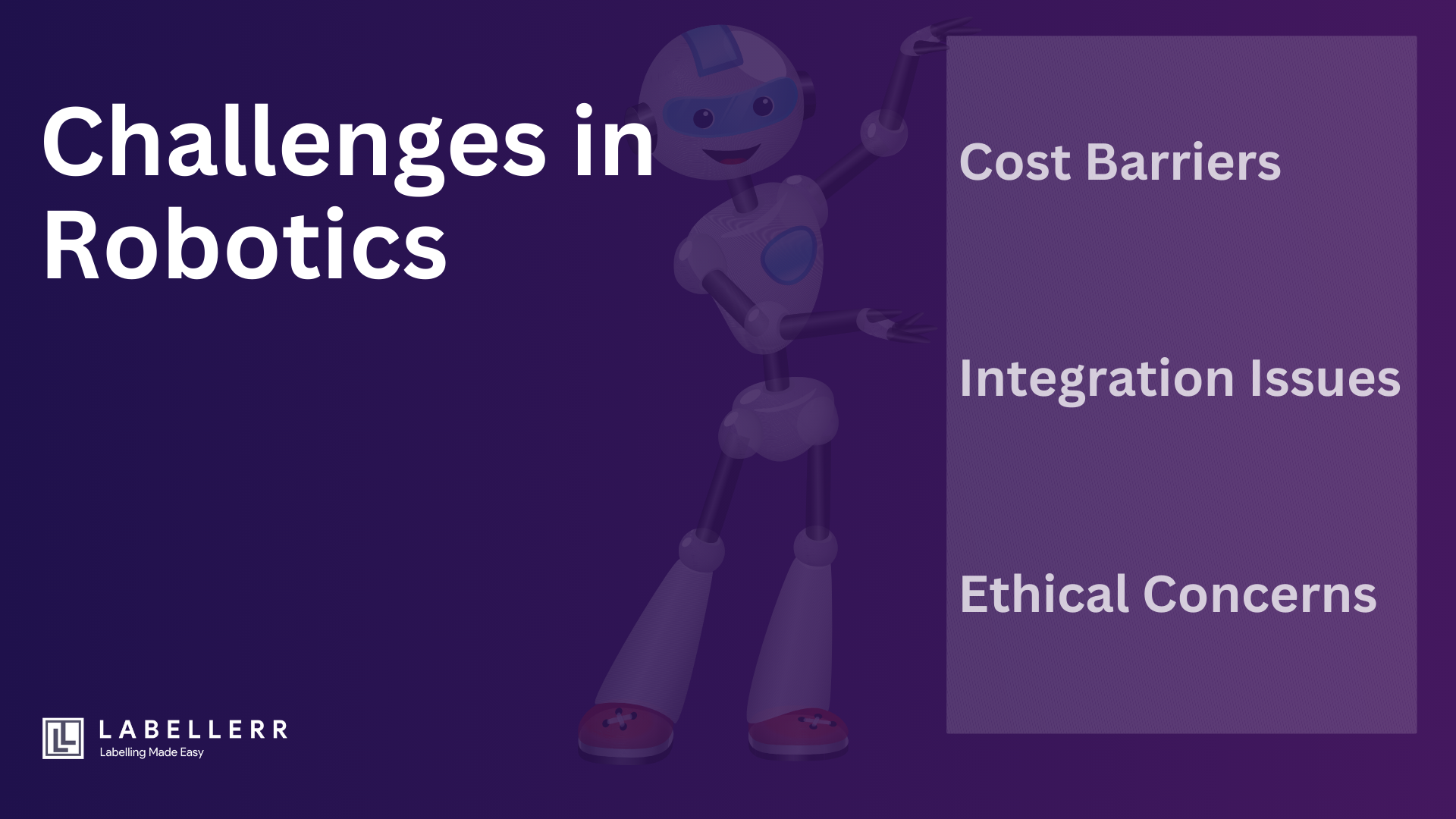
Cost Barriers for Small and Medium Enterprises (SMEs)
One of the biggest obstacles to robotics adoption is the high initial cost of robotic systems. Small and medium-sized enterprises (SMEs) often struggle to afford expensive hardware, software, and integration costs.
Purchasing industrial robots, setting up infrastructure, and maintaining these machines require a significant investment.
Larger corporations can absorb these costs, but smaller businesses risk being left behind in the automation wave. Even though automation promises long-term savings, many companies find it difficult to justify the upfront investment.
To address this issue, businesses need affordable leasing options, government incentives, and modular robotic solutions that reduce financial strain.
Ethical Concerns About Workforce Displacement
As robotics advances, concerns about job losses and workforce displacement continue to grow.
Many industries, especially manufacturing, logistics, and retail, rely on human labor for repetitive and physically demanding tasks. However, as robots take over these jobs, workers face the risk of unemployment.
Although robots improve efficiency, companies must find ways to balance automation with human employment opportunities.
The solution lies in reskilling programs, where workers are trained for new roles in robot maintenance, AI management, and quality control.
Governments and businesses must collaborate to ensure automation benefits workers rather than replacing them entirely.
Integration Issues with Existing Infrastructure
Many businesses operate with legacy systems and outdated infrastructure that were not built to support modern robotics. Upgrading these systems or integrating robots into existing workflows can be a costly and time-consuming process.
For example, manufacturing plants that rely on older machinery may need to invest in customized robots or system upgrades, which can disrupt daily operations.
Additionally, software compatibility issues can arise when trying to connect AI-driven robots with existing enterprise systems, warehouse management software, or IoT networks.
Companies must plan carefully for automation adoption by choosing flexible robotic solutions that work within their current infrastructure or developing a long-term strategy for gradual system upgrades.
Opportunities in Robotics
Advancements in AI and Machine Learning
Robots are becoming smarter, faster, and more adaptable thanks to AI and machine learning advancements.
Instead of being programmed with rigid, rule-based systems, modern robots can learn from their environments, improve their performance over time, and adapt to new challenges.
For example:
- AI-powered warehouse robots can recognize and sort items efficiently, even if packaging designs change.
- Autonomous robotic arms can improve their precision by learning from repeated tasks in manufacturing.
- Medical robots are using AI to assist in diagnosing diseases and improving surgical precision.
These AI-driven improvements increase robot efficiency, making them more useful in complex, real-world applications beyond simple, repetitive tasks.
Expansion of Robots Into New Industries
While robotics has traditionally been used in manufacturing and logistics, it is now expanding into new industries, including:
- Agriculture: AI-powered robotic arms are being used for planting, harvesting, and monitoring crop health.
- Healthcare: Robots assist doctors in surgeries, patient rehabilitation, and hospital automation.
- Retail: Automated checkout systems and robotic store assistants are improving the shopping experience.
- Construction: Robots are being developed to assist in bricklaying, welding, and automated site inspections.
As robots become more flexible, mobile, and intelligent, businesses in diverse industries are realizing the benefits of automation in improving efficiency, precision, and cost-effectiveness.
Partnerships Between Robotics Companies and Businesses
Collaboration between robotics companies and industry leaders is accelerating innovation and making robots more accessible.
Instead of developing custom robotic solutions from scratch, businesses are partnering with robotics firms to create tailored solutions for their specific needs.
For example:
- Automotive companies work with robotics firms to integrate AI-powered assembly-line robots that improve production speed and accuracy.
- Healthcare institutions collaborate with robotic developers to introduce surgical robots that enhance precision in complex procedures.
- Warehousing and logistics companies are teaming up with AI firms to automate sorting, packaging, and inventory tracking.
Some Examples
The robotics industry is advancing rapidly, with companies across various sectors leveraging automation, AI, and machine learning to improve efficiency, precision, and scalability.
The following case studies highlight how leading organizations are using robotics to solve real-world problems and push the boundaries of innovation.
Oishii
Oishii is a vertical farming company that produces high-quality strawberries indoors using AI-powered robotics and automation. Their goal is to revolutionize agriculture by growing fresh produce without pesticides, using controlled environments instead of traditional farming methods.
How They Use Robotics:
Oishii uses robotic arms and AI-driven automation to handle delicate agricultural processes, ensuring consistent quality and yield. The robots help with:
- Pollination: Robotic pollinators replace bees, ensuring efficient and controlled pollination.
- Harvesting: AI-powered robotic arms carefully pick ripe strawberries without damaging them.
- Quality Control: Vision-based AI systems inspect the fruit to ensure only the best strawberries reach customers.
- Monitoring and Adjustments: The robots analyze environmental factors like humidity, temperature, and nutrient levels to optimize growth conditions.
Impact:
- Increased efficiency: Robotics enables Oishii to harvest year-round, eliminating seasonal constraints.
- Reduced labor dependency: AI-driven robots take over repetitive tasks, allowing human workers to focus on higher-value operations.
- Minimal waste: Automated quality control ensures only the best products make it to market, reducing food waste.
Oishii’s success showcases how robotics is transforming agriculture, allowing for sustainable, high-tech farming solutions that can meet the growing demand for fresh produce worldwide.
Skild
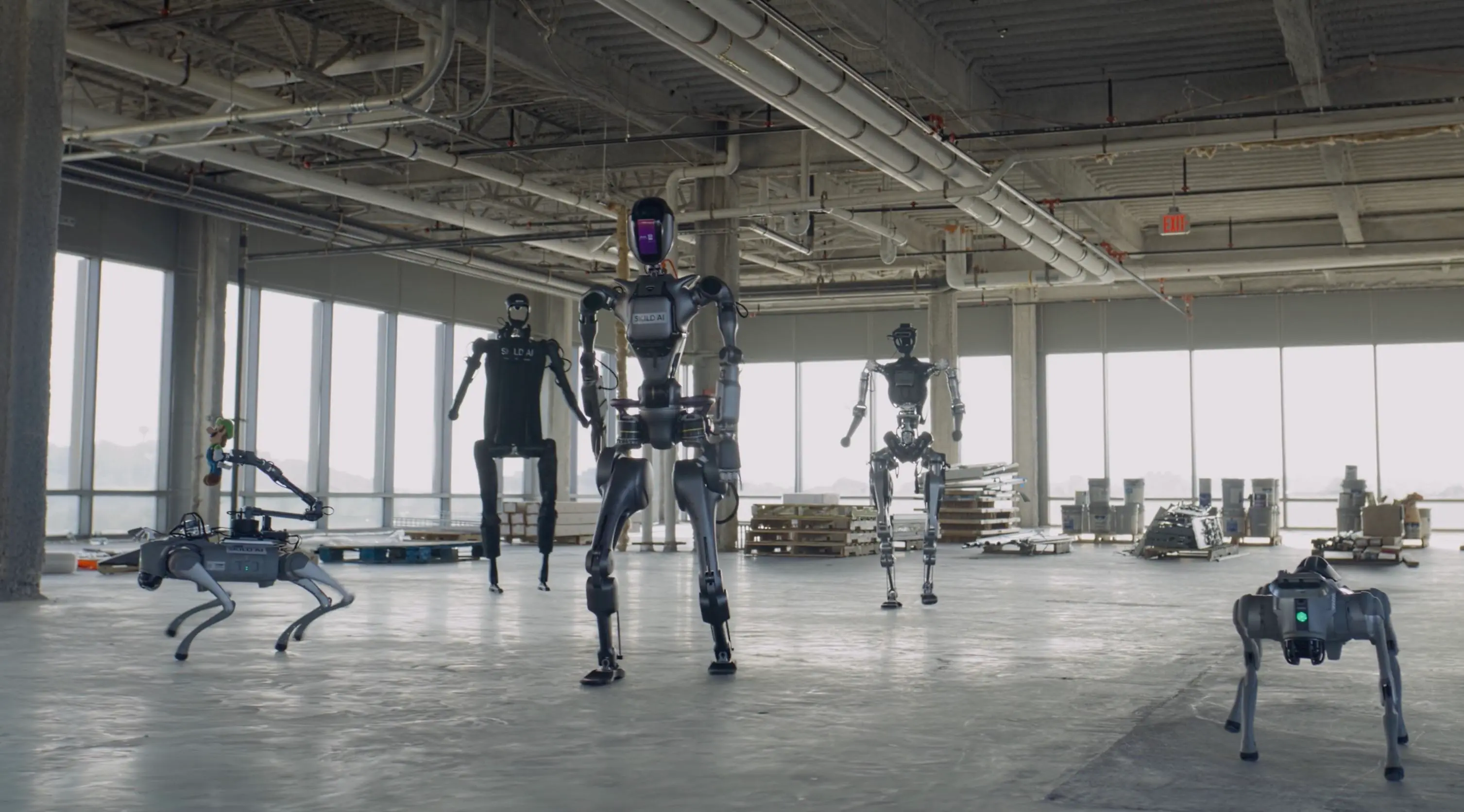
Skild is an industrial automation company specializing in custom robotic solutions for assembly lines, material handling, and quality control. They provide AI-powered robotic arms to manufacturers in electronics, automotive, and aerospace industries.
How They Use Robotics:
Skild develops adaptive robotic arms that optimize production efficiency by handling complex manufacturing processes. Their robotics applications include:
- Precision Assembly: AI-driven robotic arms assemble electronic components and mechanical parts with extreme precision, reducing human error.
- Material Handling: Automated robots transport heavy materials across factories and warehouses, improving safety and reducing strain on human workers.
- Automated Inspections: Vision-based AI systems inspect parts for defects, ensuring only high-quality products continue down the assembly line.
- Adaptive Learning: Machine learning allows robots to improve efficiency over time, making adjustments based on performance data.
Impact:
- Increased production speed: Robots perform tasks faster than human workers, reducing production bottlenecks.
- Higher accuracy and reliability: AI-driven inspections prevent defective products from reaching customers.
- Cost reduction: Automation reduces labor costs while increasing overall operational efficiency.
By using smart robotic solutions, Skild helps manufacturers remain competitive and scalable, reducing waste, improving safety, and increasing output.
Toyota Research Institute (TRI)
The Toyota Research Institute (TRI) is Toyota’s AI and robotics division, focused on advancing robotics for autonomous driving, smart mobility, and home assistance. Their goal is to develop AI-powered robots that can help humans in everyday environments.
How They Use Robotics:
TRI is developing next-generation robotics solutions that focus on:
- Autonomous Vehicles: AI-powered robotics improve self-driving technology, allowing vehicles to navigate complex environments safely.
- Smart Home Assistance: Toyota’s home-assist robots help elderly and disabled individuals with daily tasks like cooking, cleaning, and mobility support.
- Human-Robot Collaboration: Unlike traditional factory robots, Toyota’s AI-enhanced robots learn from human interactions to perform tasks in real-world environments.
Impact:
- Enhanced safety: Toyota’s AI-driven robotics improve vehicle navigation, reducing accidents caused by human error.
- Aging population support: Their home-assist robots improve quality of life for elderly individuals, providing support in everyday tasks.
- Smart factory automation: Toyota’s AI-powered robots optimize production lines, reducing downtime and increasing efficiency.
By investing in robotics-driven mobility solutions, Toyota is shaping the future of smart transportation and home automation, making robotics more accessible in everyday life.
Future Outlook for Robotics Beyond 2025
The robotics industry is evolving rapidly, and by 2025, robots will become smarter, more adaptable, and widely integrated into different industries.
With advancements in artificial intelligence (AI), automation, and machine learning, robots will continue to redefine efficiency and productivity across sectors like healthcare, manufacturing, logistics, and agriculture.
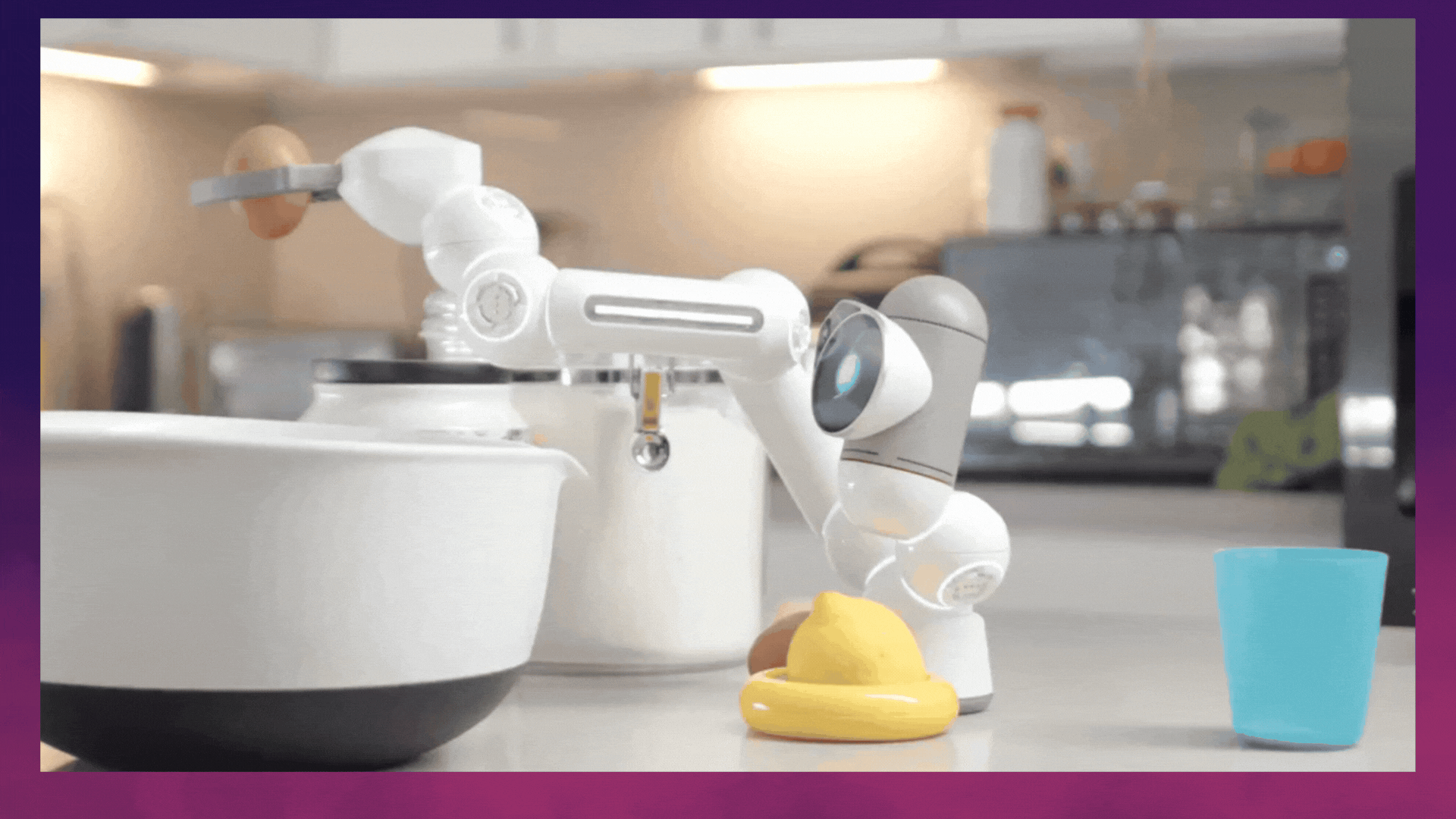
Predictions for Robotics Beyond 2025
Continued Growth in AI-Driven Robots
AI will play a crucial role in making robots more intelligent and autonomous. Future robots will not only execute pre-programmed commands but will learn from their environment, adapt to changes, and make complex decisions in real time.
- Healthcare: AI-powered robots will assist in surgeries, diagnose diseases, and support elderly care with precision and efficiency.
- Logistics: Smart robots will automate warehouse operations, optimize supply chains, and enhance last-mile deliveries.
- Retail: AI-driven robots will improve in-store automation, restock shelves, and enhance customer interactions.
With AI advancements, robots will become more intuitive, reducing human intervention while improving overall performance.
Enhanced Adaptability and Collaboration
Future robots will be more flexible and capable of handling diverse tasks across multiple industries. Instead of robots being designed for a single, repetitive task, they will adapt to changing needs without extensive reprogramming.
- Collaborative robots (cobots) will work alongside humans, helping with precision tasks in manufacturing, patient care in healthcare, and labor-intensive processes in agriculture.
- Robots will use machine learning to improve performance over time, ensuring they become more efficient with each completed task.
- AI will enable robots to switch between different roles, such as harvesting crops in the morning and assembling electronic components in the evening.
As human-robot collaboration increases, robots will enhance productivity while allowing workers to focus on more complex and creative tasks.
Key Trends Shaping the Future of Robotics
1. Increased Use of Edge Computing
Robots will rely more on edge computing, allowing them to process data in real time rather than depending on cloud servers.
- This technology will improve response times, making robots more effective in high-speed environments like autonomous vehicles and real-time medical procedures.
- Manufacturing robots will detect defects instantly, preventing faulty products from moving forward in production.
Edge computing will minimize delays, enhance decision-making, and ensure data security by reducing reliance on external networks.
2. Expansion of Robotics into New Industries
Robotics is no longer limited to factories and warehouses—it is expanding into agriculture, healthcare, construction, and even space exploration.
- Agriculture: Robots will automate planting, watering, and harvesting to improve efficiency and reduce waste.
- Healthcare: Medical robots will assist doctors in surgeries, rehabilitation, and patient care.
- Construction: Autonomous machines will handle bricklaying, welding, and even large-scale infrastructure projects.
As robotics becomes more versatile, industries will adopt automation at an unprecedented rate.
3. Sustainability and Energy-Efficient Robotics
As industries prioritize sustainability, robotics will play a key role in reducing energy consumption and waste.
- AI-powered robots will optimize energy use by adjusting their functions based on real-time needs.
- Manufacturing robots will reduce material waste by improving precision in assembly and quality control.
- Agricultural robots will minimize pesticide and water usage, promoting eco-friendly farming.
Sustainable robotics will support industries in reducing environmental impact while maintaining high efficiency.
4. Rise of Soft Robotics for Delicate Tasks
Soft robotics—robots made of flexible materials—will be increasingly used for delicate and precise applications.
- Healthcare: Soft robots will handle delicate surgical procedures and assist in physical therapy.
- Food Industry: Robots with soft grippers will handle fresh produce without causing damage.
- Retail & Warehousing: Flexible robots will handle fragile goods with improved care.
Soft robotics will enable automation in areas where traditional rigid robots were too forceful or imprecise.
5. AI-Powered Self-Learning Robots
Robots will train themselves using AI and machine learning, reducing the need for human programming.
- Autonomous vehicles will improve driving algorithms by learning from real-world experiences.
- Industrial robots will refine their assembly techniques based on past errors and successes.
- Household robots will adapt to different home layouts, making them more user-friendly.
Self-learning robots will continually improve their efficiency and reliability, making automation even more powerful.
Conclusion
In 2025, robotics is experiencing significant growth, driven by advancements in AI, automation, and smart technologies.
Robots are now essential in various sectors, from healthcare and logistics to manufacturing and agriculture.
They streamline operations, enhance precision, and improve productivity. This rapid growth shows that robotics is not just a trend but a vital part of the future.
Tau Robotics stands out in this evolving landscape. They focus on developing general-purpose AI for robotic arms, making them versatile and effective across different industries.
Their innovative technology helps businesses achieve greater efficiency and accuracy, whether in delicate surgeries, fast-paced manufacturing lines, or automated farming.
Tau Robotics’ commitment to integrating AI into robotics is helping industries overcome challenges like high costs, integration issues, and workforce concerns.
Their solutions make robotics more accessible and practical for businesses of all sizes, paving the way for broader adoption and innovation.
As we look to the future, Tau Robotics aims to push the boundaries of what robotic arms can do. By enhancing adaptability and intelligence, they are setting new standards in robotics and preparing industries for a more automated and efficient tomorrow.
Explore the groundbreaking work of Tau Robotics and discover how their innovations are driving the future of AI-powered robotics. Visit their website, learn about their projects, and see how their technology can transform your industry. Tau Robotics is not just building robots—they are shaping the future of how we work and live.
FAQs
How is robotics expected to grow in 2025?
Robotics is experiencing rapid growth, driven by advancements in AI, automation, and IoT. Industries like healthcare, logistics, manufacturing, and agriculture are adopting robotics to improve efficiency, reduce costs, and meet growing demands.
Which industries benefit the most from robotics advancements?
Healthcare, logistics, manufacturing, and agriculture are some of the top industries benefiting from robotics. Robots assist in surgeries, automate warehouses, streamline production lines, and enable precision farming practices.
What are the biggest challenges and opportunities in robotics?
Challenges include high costs for small businesses, workforce integration, and ethical concerns about job displacement. Opportunities lie in advancements in AI, the expansion of collaborative robots, and the increasing adoption of robots in new industries.

Simplify Your Data Annotation Workflow With Proven Strategies
.png)


